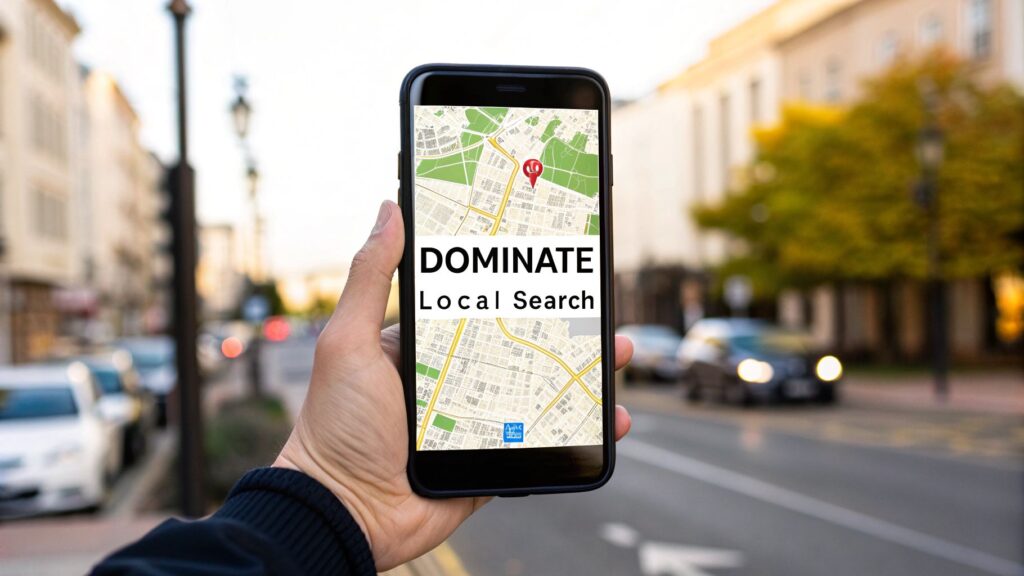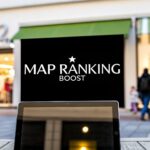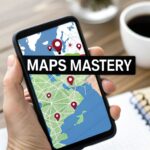Photography SEO is about getting your website to show up on Google when clients are looking for a photographer like you. When someone types “newborn photographer dallas” into the search bar, you want to be the first name they see. It's how you turn online searches into paying clients.
Why Your Photography Business Needs SEO
You can have the most beautiful portfolio in the world, but it won’t book jobs if no one can find it. Think of your website as your digital storefront. If it's on page ten of Google, it’s like a shop in a hidden alley. Good photography SEO moves you to the main street, right in front of people looking to hire you.
Your ideal clients are on Google right now, planning events and searching for vendors. They need a photographer. SEO is your most powerful marketing tool because it connects you with them at that exact moment. It’s about making a genuine connection when they need your talent most.
For a great primer on how to get your business seen online, this guide on Mastering Organic Search Engine Optimisation is a fantastic starting point.

Stand Out in a Crowded Market
The photography world is competitive. With the global market hitting over $50 billion in 2023, you need to be more than a great artist—you must be a smart business owner. In this environment, SEO is essential.
When you invest in SEO, you're building a lead-generating machine that works 24/7. Unlike paid ads that stop when you stop paying, a solid SEO foundation brings in quality leads for free. It's a long-term asset for your business.
In Short: SEO turns your website from a quiet online gallery into a powerhouse that consistently brings in the clients you want to work with.
The Big Wins: Key Benefits of SEO for Photographers
So, what’s the real payoff? Here’s what you get when you nail your SEO:
- Get Seen by Locals: You'll appear when people in your city or region are looking for a photographer.
- Better-Fitting Leads: You'll attract clients who are already looking for your specific style of photography.
- Become the Go-To Pro: Ranking high on Google builds trust and positions you as a respected expert.
- Smarter Marketing Spend: SEO delivers a better long-term return on investment than paid ads.
How do I find keywords for my photography website?
Let's get real about photography SEO. It all comes down to figuring out what your ideal clients are typing into Google. It’s time to move past generic terms and find the phrases people use when they’re ready to hire someone.
Think about it. A person searching "family photo ideas" is just browsing. But someone searching for "candid outdoor newborn photos dallas" has a clear vision and is ready to book. That’s the magic of targeting the right kind of keywords.
These longer, more specific phrases are called long-tail keywords. They don't get millions of searches, but the people who use them know exactly what they want. They convert very well.
How to Find Your Money-Making Keywords
The best place to start is by thinking like your client. What are they worried about? What kind of photoshoot are they dreaming of? Start by brainstorming your main services and the areas you serve.
Your first list might look like this:
- Wedding photographer in Austin
- Newborn photographer in San Diego
- Elopement photographer in Colorado
This is a great starting point. From here, we can dig deeper to find those long-tail gems that real people are searching for every day.
The Goal: Uncover the exact words your target audience uses when they're actively looking to hire a photographer for a specific shoot in your location.
Uncover What Clients Are Really Searching For
You don't need expensive tools to get started. Google itself is one of the most powerful resources you have, and it's 100% free.
Ever noticed the "People Also Ask" box in your search results? That's a goldmine. It's Google telling you the exact questions people have about your services.
For example, a search for "maternity photographer" could bring up questions like:
- When should you take maternity photos?
- How much does a maternity photoshoot cost?
- What should I wear for a maternity shoot?
Each of those is a blog post topic or a FAQ section for your services page. By answering these questions on your site, you position yourself as an expert and start ranking for those valuable terms.
Another simple trick is to use Google's autocomplete. Start typing a phrase like "adventurous elopement photographer…" and see what Google suggests. You might find "…colorado mountains" or "…pacific northwest." Those are real searches from real people.
Mapping Your Keywords to Your Website
Once you have a good list of keywords, you need to assign them to specific pages on your website. This helps Google understand what each page is about. Don't sprinkle your main keyword on every single page; that just confuses search engines.
Here’s a simple way to organize it:
- Homepage: This is for your main keyword, like "San Francisco Wedding Photographer."
- Service Pages: Get more specific. Create dedicated pages for "San Francisco Engagement Photos" or "City Hall Wedding Photographer."
- Blog Posts: This is for long-tail, question-based keywords. Write helpful articles like "Best Photo Locations in Golden Gate Park" or "How to Plan a Surprise Proposal in Napa Valley."
By giving each keyword a logical home, you create a clear roadmap for both visitors and search engines.
Optimizing Your Images and Website Pages

Your images are the heart of your business, but Google can't see them like a client can. To a search engine, a beautiful photo is just code. Our job is to translate that visual magic into clear signals that tell Google what your page is about. This is the foundation of good photography SEO.
Of course, the words and structure around your images matter just as much. When you get this combination right—optimized photos on a well-structured page—you'll start climbing the search rankings.
Making Your Images Work for You
Every photo you upload is an opportunity to boost your SEO. If you're still uploading files named IMG_9876.jpg, you're missing out. Each image can be a tiny billboard for your business, but only if you give it the right information.
A solid image optimization workflow doesn't need to be complicated, but it does need to be consistent. You have to do it for every single image.
This is the basic flow to follow, which covers everything from the page's title tag to image compression and alt text.

A complete on-page strategy starts with page-level elements like the title, then drills down to the media itself. It’s all about making sure every piece sends the same strong signals to Google.
Name Your Image Files Like a Pro
Before a photo touches your website, change the file name. This is your first and easiest win. It gives Google a direct signal about the image's subject. Be descriptive and use your keywords naturally.
- Don't do this:
DSC_0123.jpg - Do this instead:
denver-botanic-gardens-wedding-portrait.jpg
The second name instantly tells Google the location, event type, and what's in the photo. Always use lowercase letters and separate words with hyphens.
Write Alt Text That Actually Ranks
Alternative text (alt text) is a short, written description of an image. It helps visually impaired users with screen readers understand your content. It also gives search engines powerful context, which helps your work get discovered in Google Images.
When writing alt text, just be descriptive.
My favorite tip: Write your alt text as if you're describing the photo over the phone to someone who can't see it. This simple mindset shift forces you to be descriptive and helpful.
Let's look at an example:
- Weak Alt Text:
bride and groom - Strong Alt Text:
Bride and groom kissing during a sunset ceremony at their Aspen Mountain wedding.
The strong version is packed with details and valuable keywords like "Aspen Mountain wedding," painting a clear picture for both people and search engines.
The Need for Speed: Image Compression
Page speed is a requirement. A recent study showed that 47% of users will leave if a page takes more than two seconds to load. The number one cause of slow photography websites? Large, uncompressed image files.
You must compress your images before uploading them. The goal is to shrink the file size without making the photo look blurry. There are great tools for this, like TinyPNG, JPEGmini, or plugins like ShortPixel.
As a rule of thumb, try to keep every image under 200KB. This step can dramatically improve your user experience and boost your SEO.
Your Essential Image SEO Checklist
Feeling overwhelmed? Don't be. Use this quick reference for every photo you upload.
| Optimization Task | What to Do | The SEO Benefit |
|---|---|---|
| File Naming | Rename the file before uploading. Use keywords separated by hyphens (e.g., brand-name-service-location.jpg). |
Gives Google immediate context about the image's subject matter. |
| Image Compression | Use a tool to reduce the file size, aiming for under 200KB without sacrificing quality. | Dramatically improves page load speed, a critical ranking factor. |
| Alt Text | Write a concise, descriptive sentence explaining the image. Include relevant keywords naturally. | Helps Google understand the image for Image Search and improves accessibility. |
Following these three steps for every image will put you miles ahead of the competition.
Structuring Your Pages for Humans and Bots
With images optimized, let's talk about the page itself. The way you organize content with titles and headings creates a roadmap for visitors and search engine crawlers.
Crafting Compelling Title Tags
The title tag is the blue, clickable headline in Google's search results. It's one of the most important on-page SEO elements. Every page needs a unique title tag that accurately describes its content.
A simple formula that works is:
Primary Keyword | Secondary Keyword | Your Brand Name
For a portfolio page, that might look like:San Diego Wedding Photography | Balboa Park Weddings | Jane Doe Photo
Using Headings to Create a Clear Hierarchy
Headings (H1, H2, H3) are like chapter titles. They break up your text and create a logical outline.
- H1 Tag: This is your page's main headline. You get one H1 tag per page. It should feature your primary keyword.
- H2 Tags: Use these for major sections of your page.
- H3 Tags: Use these to break down topics within your H2 sections.
This structure makes your content easier to read and helps Google understand how the information on your page is related.
Winning Local Search to Book Nearby Shoots
Most photography businesses rely on clients in their own backyard. This is where mastering local photography SEO becomes a game-changer.
The goal is to ensure that when someone in your town Googles "family photographer near me," your name is at the top of the list. It's about being the obvious choice for local clients ready to hire.
Your Most Powerful Local SEO Tool
Your single most important tool for local clients is your Google Business Profile (GBP). It's the free listing that appears in Google Maps and the "Map Pack" in search results. Think of it as your digital storefront on Google.
If you do nothing else, optimize your GBP.
- Get Your Categories Right: Be specific. Are you a "Wedding Photographer" or a "Portrait Studio"? Add both primary and secondary categories.
- Fill In Every Single Blank: Add your services, hours, a business description with local keywords, and lots of your best photos.
- Geotag Your Images: Before uploading photos, use a tool to geotag them with the location where they were taken. This tells Google your work is relevant to that area.
Keep Your Business Info Consistent Everywhere
Your business Name, Address, and Phone Number (NAP) must be identical everywhere it appears online.
This consistency is a huge trust signal for search engines. When Google sees the same NAP on your website, GBP, and Facebook page, it becomes confident your business is legitimate. Even a small difference, like "St." versus "Street," can cause confusion.
Pro Tip: Search for your business name and check the top 10 results. Fix any inconsistencies you find. It’s a foundational step for solid local SEO.
Build Credibility with Local Citations and Reviews
Your business information should also be listed in other reputable online directories. These are called citations. Getting listed on sites like Yelp, The Knot, or your local Chamber of Commerce website reinforces your connection to your city. For small businesses, this is a core part of how local SEO services for small business build a strong local presence.
Of course, nothing works like great reviews. After a session, ask every happy client for a review on your Google Business Profile.
- Make it Easy: Send a direct link to your review page.
- Respond to Every Review: Thank people for good reviews and professionally address any bad ones.
Create Location-Specific Pages on Your Website
If you serve more than one city, build dedicated pages for each one. Create unique, helpful pages that speak directly to clients in those areas.
For instance, you could create:
- A "Houston Engagement Photographer" Page: This page could feature a gallery of photos from iconic Houston spots and include testimonials from local couples.
- A "The Woodlands Family Photographer" Page: Here, you could showcase sessions from popular parks and share tips on family-friendly photo locations.
Creating these pages helps you rank for specific, high-intent searches. You're signaling to Google, "I am the expert for this service in this exact place."
Building Authority to Become a Trusted Name

Ranking on Google is about more than just keywords. Google’s job is to connect people with trustworthy and credible sources. For your photography business, this means building your website's authority.
Think of authority as your online reputation. The stronger it is, the more Google trusts you, and the higher you'll rank.
This trust is built mostly through backlinks. A backlink is a link from another website to yours. Each one acts like a vote of confidence, telling Google your work is valuable. It's about earning high-quality, relevant links from respected sources.
How to Earn Links That Matter
The best backlinks come from websites in the photography world. A link from a popular wedding blog or a local venue’s website is gold. The strategy is to build relationships and create content that naturally attracts these links.
Here are a few ways to do this:
- Get Your Work Featured: Submit your best shots to wedding, family, or travel blogs. When they feature your photos, they’ll almost always link back to your site.
- Team Up with Local Vendors: Offer vendors like florists and planners professional photos for their own websites in exchange for a spot on their "preferred vendors" page with a link back to you.
- Create "Linkable" Content: Create helpful resources people want to share. A blog post like "The Top 10 Overlooked Photo Locations in San Diego" is a valuable asset that other local businesses would be happy to link to.
Don't Forget to Link Your Own Pages
How you link between your own pages—called internal linking—is also crucial. Good internal links create a roadmap that guides visitors and Google through your site.
For example, when you publish a blog post about a wedding at a specific venue, always link from that post back to your main wedding portfolio page. This tells Google that your portfolio is a cornerstone of your site.
A Nuoptima study found that the first page of Google gets about 71% of all clicks. The second page gets only 6%. If you're not on page one, you’re missing out on potential clients. Smart linking is one of the best ways to get there.
Answering Your Top Photography SEO Questions
Let's get into some common questions photographers have about photography SEO. Getting clear answers can make all the difference.
How long does SEO take to work for photographers?
This is the big one. The honest answer is that SEO is a marathon, not a sprint. It's a long-term strategy.
While you might see small results in a few weeks, especially with local SEO, real, lasting results take time.
You should plan on seeing significant growth in your rankings and organic traffic within about 4 to 6 months. You're building trust with Google, and that doesn't happen overnight. Patience and consistency are key.
In Short: Don't get discouraged if you're not an overnight success. A solid SEO strategy needs 4-6 months to start delivering a consistent flow of leads.
Does a photographer need a blog for SEO?
Technically, no. But not having a blog is like trying to shoot a wedding with just one lens—you’re leaving your most powerful tool in the bag. A blog is your secret weapon for attracting clients.
A blog lets you:
- Target Long-Tail Keywords: You can write posts answering the exact questions clients are typing into Google, like "best spots for fall engagement photos in Asheville."
- Showcase Your Work Strategically: Every session can become a blog post. That wedding at "The Grand Estate"? Blog it. Now you can rank for people searching for that venue.
- Become the Go-To Expert: Sharing helpful tips and beautiful work builds trust and authority.
Imagine a couple searching for photos of their dream venue and finding your blog post from a wedding you shot there. That’s a pre-sold client who already loves your style.
What is more important for SEO: keywords or backlinks?
This is a classic "chicken or the egg" debate. The truth is, they're both critical and work together.
Here’s how to think about it:
- Keywords are your foundation. They are the bedrock of your on-page SEO. Keywords tell Google what your website is about. Without the right keywords, Google is just guessing.
- Backlinks are your reputation. These are links pointing to your site from other websites. Each backlink is like a vote of confidence, telling Google, "Hey, this photographer knows their stuff."
You need a solid foundation of keywords first. Then, when you start getting backlinks, they have the maximum impact. A site with perfect keywords but no backlinks will struggle, while a site with lots of backlinks but messy content won't attract the right traffic. This balance is especially crucial for niches like SEO for wedding photographers.
At Clicks Geek, we specialize in turning your website into a powerful client-acquisition tool with proven SEO and digital marketing strategies. https://clicksgeek.com
Is Your Business Ranking in Google Maps?
Turn Google Maps into a Lead Engine w/ Clicks Geek’s AI-powered local SEO. 3,000+ clients served. Our proprietary, fully done-for-you Maps SEO system handles everything—keyword targeting, local optimization, content, reviews, and ranking strategy—automatically.






